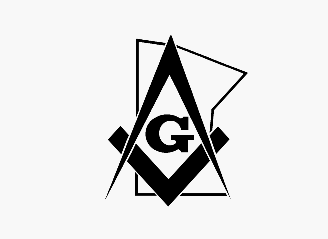 1
MINNEAPOLIS
Est. 1852
CATARACT
LODGE NO. 2
A. F. & A. M.
|
|
2
What is Freemasonry?
(This is the text of a leaflet published by by the Board of General Purposes of
the United Grand Lodge of England in 1984. The UGLE is a sister grand lodge
to the Grand Lodge of Minnesota. One grand lodge does not speak for, or
make policy for another, but this excellent essay describes Masonry in
universal terms that are as applicable in Minnesota as they are in England.)
Introduction: Freemasonry is one of the world's oldest secular fraternal
societies. This leaflet is intended to explain Freemasonry as it is practiced
under the United Grand Lodge of England, which administers Lodges of
Freemasons in England and Wales and in many places overseas. The
explanation may correct some misconceptions. Freemasonry is a society of
men concerned with moral and spiritual values. Its members are taught its
precepts by a series of ritual dramas, which follow ancient forms and use
stonemasons' customs and tools as allegorical guides.
The Essential Qualification for Membership:
The
essential qualification for admission into and continuing membership is a belief
in a Supreme Being. Membership is open to men of any race or religion who
can fulfill this essential qualification and are of good repute.
Freemasonry and Religion:
Freemasonry is not a religion, nor is
it a substitute for religion. Its essential qualification opens it to men of many
religions and it expects them to continue to follow their own faith. It does not
allow religion to be discussed at its meetings.
The Three Great Principles:
For many years Freemasons have
followed three great principles:
Brotherly Love
- Every true Freemason will show tolerance and
respect for the opinions of others and behave with kindness and
understanding to his fellow creatures.
Relief
- Freemasons are taught to practice charity, and to care, not
only for their own, but also for the community as a whole, both by
charitable giving, and by voluntary efforts and works as individuals.
Truth
- Freemasons strive for truth, requiring high moral standards
and aiming to achieve them in their own lives.
Freemasons believe that these principles represent a way of achieving higher
standards in life.
|
|
3
Charity: From its earliest days, Freemasonry has been concerned with
the care of orphans, the sick and the aged. This work continues today. In
addition, large sums are given to national and local charities.
Freemasonry and Society:
Freemasonry demands from its
members a respect for the law of the country in which a man works and
lives. Its principles do not in any way conflict with its members' duties as
citizens, but should strengthen them in fulfilling their private and public
responsibilities. The use by a Freemason of their membership to promote
his own or anyone else's business, professional or personal interests is
condemned, and is contrary to the conditions on which he sought
admission to Freemasonry. His duty as a citizen must always prevail over
any obligation to other Freemasons, and any attempt to shield a Freemason
who has acted dishonorably or unlawfully is contrary to this prime duty.
Secrecy:
The secrets of Freemasonry are concerned with its traditional
modes of recognition. It is not a secret society, since all members are free
to acknowledge their membership and will do so in response to inquiries
for respectable reasons. Its constitutions and rules are available to the
public. There is no secret about any of its aims and principles. Like many
other societies, it regards some of its internal affairs as private matters for
its members.
Freemasonry and Politics: Freemasonry is non-political, and
the discussion of politics at Masonic meetings is forbidden.
Other Masonic Bodies: Freemasonry is practiced under many
independent Grand Lodges with standards similar to those set by the
United Grand Lodge of England. There are some Grand Lodges and other
apparently Masonic bodies which do not meet these standards, e.g. which
do not require a belief in a Supreme Being, or which allow or encourage
their members to participate in political matters. These Grand Lodges and
bodies are not recognized by the United Grand Lodge of England as being
masonically regular, and Masonic contact with them is forbidden.
Conclusion:
A Freemason is encouraged to do his duty first to God
(by whatever name he is known) through his faith and religious practice;
and then, without detriment to his family and those dependent on him, to
his neighbor through charity and service. None of these ideas is
exclusively Masonic, but all should be universally acceptable. Freemasons
are expected to follow them.
|
|
4
ACT ESTABLISHING CATARACT LODGE #2
Chapter 72 Private Acts of the Territory of Minnesota 1853.
(Chapter 17, Laws of Minnesota, 1853)
An Act to incorporate the Grand Lodge of Ancient Free and Accepted
Masons of Minnesota.
Be it enacted by the Legislative Assembly of the Territory of
Minnesota:
SECTION 1. That Alfred E. Ames, the present Grand Master, Aaron
Goodrich, Deputy Grand Master, Daniel F. Brawley, Senior Grand
Warden, and Abram Van Vorhes, Junior Grand Warden of Ancient Free
and Accepted Masons, of Minnesota, and D. B. Loomis, J. C. Ramsey, E.
Case and A. T. C. Pierson, as trustees, and their successors in office, be,
and they are hereby declared to be, a body politic and corporate, by the
name and style of "The Grand Lodge of Minnesota," may have and
keep a common seal, and the same alter, change or renew at pleasure; and
by their corporate name may sue and be sued, plead and be impleaded, in
all courts, either of law or equity, and shall have perpetual succession.
SECTION 2. Said Grand Lodge shall be established in St. Paul, and in
their corporate name may contract and be contracted with, may receive by
gift or purchase, and may hold and convey real and personal estate to the
amount of fifty thousand dollars, and may make such by-laws, rules and
regulations as they may deem best: Provided, That such by-laws, rules and
regulations be not contrary to the constitution of the United States, or of
the organic act of this Territory.
SECTION 3. That Alfred E. Ames, the present W. Master, D.
M. Coolbaugh, Senior Warden, and C. T. Stearns, Junior
Warden of Cataract Lodge, No. 2, of Ancient Free and
Accepted Masons and their successors be, and they are hereby,
declared to be a body politic and corporate, by the name and
style of "Cataract Lodge, No. 2 of St. Anthony", and by such
name may have and possess all the rights and privileges given
the Grand Lodge in the first and second sections of this act.
|
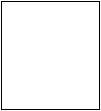  5
HISTORY OF CATARACT LODGE
Cataract Lodge's beginnings coincide with the
establishment of Masonry in Minnesota and precede the
formation of the Grand Lodge. When Freemasonry planted its
roots in this region, Minnesota had just been made a Territory.
In 1849, St. Paul had only thirty houses and a population of
two hundred, St. Anthony was a hamlet. Fort Snelling stood
where Minneapolis sprawls today.
The formation of Cataract Lodge was largely due to the
efforts of Worshipful Brother Alfred Elisha Ames. During
November 1851, he had examined Masonically each
prospective member of the proposed Lodge. On December 1,
1851, a petition for a dispensation was dispatched to Thomas
Pickett, Grand Master of Illinois. This was
granted on February 5, 1852. The Brethren
assembled at the home of Ard Godfrey on
February 14, 1852, and Cataract Lodge No. 121
of Illinois was duly instituted under
dispensation. This is also the date of the first
Communication regularly held by the Lodge.
The first officers of Cataract Lodge No. 121
were: Alfred Elisha Ames, Worshipful Master; William Smith,
Senior Warden; Isaac Brown, Junior Warden; Ard Godfrey,
Treasurer; John H. Stevens, Secretary; D. M. Coolbaugh,
Senior Deacon; H. S. Atwood, Junior Deacon; and Wilhelm
Brainer, Tyler.
The Lodge was chartered October 5, 1852, and
Constituted October 21, 1852.
On February 23 and 24, 1853, the Grand Lodge of
Ancient Free and Accepted Masons of Minnesota was formed.
Alfred Elisha Ames was elected the first Grand Master of the
Grand Lodge. Charters were then issued to the following
Lodges:
St. John's Lodge No. 1, Stillwater
(formerly No. 39 of Wisconsin, June 9, 1853)
|
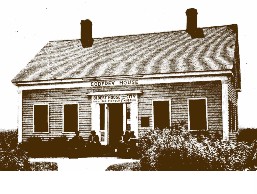 6
Cataract No. 2 of St. Anthony
(formerly No. 121 of Illinois, October 5, 1852).
St. Paul No. 3 of St. Paul
(formerly No. 223 of Ohio, January 24, 1853).
In addition to the officers, the following were charter
members of Cataract Lodge: Emanuel Cawe, Isaac Atwater,
John G. Lennon, Chessman Gould, Benjamin F. Whitson, C.
A. Newcomb, Joseph Dean, J. P. Wilson, A. H. Mills, M. W.
Getchell, C. W. Borup, George T. Vail, Edward Patch, Frank-
lin Steele, Isaac L. Lewis, John Reidhead Sr., D.E.Moulton,
Edmund Rice, J. W. T. Gardner, Charles T. Stearns, B. F.
Batchelor, John C. Gains, John H. Murphy, John McDonald,
Robert W.Cummings, Joseph McAlpine, C. G. Rogers, Anson
Northrup, Edward Murphy, George Charles Mansuer, George
A. Camp, John Reidhead, Jr., A. L. Cummings, and J. W.
Babcock.
The Former Homes of the Lodge
In the early days few suitable places were available for
meetings. Being unable to build a lodge home, it was
necessary to rent hall space for more than twenty years.
Brother Ard Godfrey built a small house in 1848 at Main
Street and Second Avenue S.E. in St. Anthony. ( Located at
Chute Square since 1909, the Godfrey House is thought to be
Ard Godfrey House 1853
|
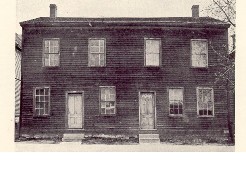 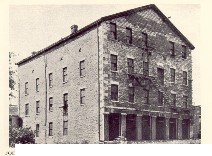 7
the oldest house still standing in Minneapolis.) It was in the
Godfrey House private parlor that the first Communication of
Cataract Lodge U. D. was held Saturday, February 14, A. D.
1852, A. L. 5852 at 7 P.M.
The
first
lodge hall used was located on Main Street N. E. just above
Fourth Avenue. From this place the Lodge moved to a hall in
the building later known as the Tremont House at Main Street
S. E. and Second Avenue. Later it moved to the King Building
two blocks further down and remained there until the building
was destroyed by fire. For a time the Lodge had no regular
quarters but met in various places.
In 1857 a hall was secured in Capt. John Rollins'
building at Second Avenue and Prince Street.
Cataract's First Lodge Hall - Main Street N. E.
above Fourth Avenue Minneapolis 1853-1856
John Rollins Building 1857-1874
|
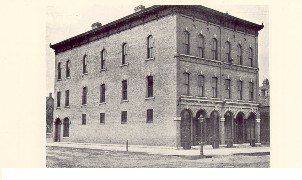 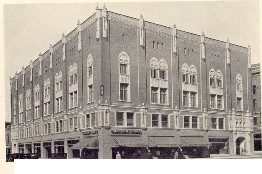 8
There
were no other lodge quarters until the construction of the building
at University Avenue and Bank Street in 1874, which the Lodge
occupied for 52 years.
In 1926 the Lodge moved to its new building at the corner
of Central Avenue and Fourth Street S.E. in Minneapolis. The
corner stone was laid by the Grand Lodge, A.F.&A.M. of
Minnesota on August 11, 1925, 51 years to the day after laying
of the corner stone of the previous building on University and
Bank Street. The building was semi-commercial, with stores on
the first floor and offices on the second floor. Cataract Lodge
occupied the balance of this building for twenty years until 1946.
University Avenue S.E. & Bank Street
1874-1926 and 1946-1961
107 Fourth Street S.E. 1928-1946
|
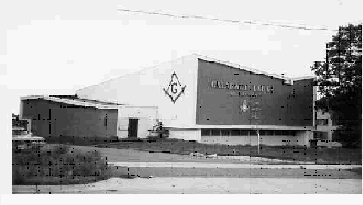 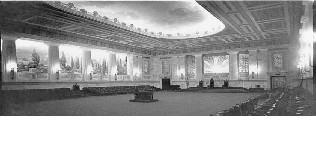 9
At that time circumstances including the loss of over 800
members to the newly-formed University Lodge, high taxes and
low rental income forced the Lodge to give up this building. It
moved back to its old home at University and Bank Streets. It was
like "old times" in this building as Cataract Lodge again
prospered and grew. Proceeding at a leisurely pace were plans for
a new "all-on-one floor" Lodge which would permit attendance
by the more elderly members to whom the building's three flights
of stairs were bothersome. These plans were expedited in early
1960 when the building was demolished for a parking lot.
The Golden Valley Years 1962-1978
The Lodge again was forced into borrowed quarters until
its new building at 7445 Glenwood Avenue in Golden Valley was
completed. Its first stated meeting in its new quarters was
December 3, 1961.
Lodge Hall or "Gold Room" at 107 Fourth Street S.E.
7445 Glenwood Avenue, Golden Valley 1962-1978
|
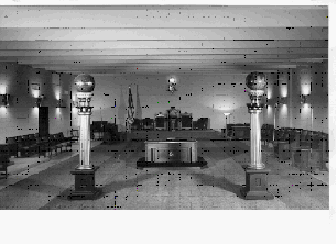 10
Rereading copies of Cataract News from this period
recalls how busy we were with Lodge activities.
At the time we constructed our Golden Valley Lodge
Hall, city water was not yet available and we had a deep well.
Anticipating city water we installed a copper pipe from the
building to the street aimed directly at Schuler's tavern,
across the street. We were accused of planning a beer
pipeline!
This
was a period of membership growth, with degree work
starting every three months, limited by Grand Lodge edict to
ten candidates at a time. With the regular repeat
performances, we became very proficient with our ritual
work.
During these years Cataract's Fellowcraft Club (whose
dues were $3.57 per year) held pancake breakfasts and other
periodic special events to raise money to pay for building
improvement items such as carpet, floor and ceiling tile,
cabinets, and parking lot improvements. These special events
were intermixed with activities such as fishing trips, picnics,
past masters' roasts, bowling in the Masonic Bowling league,
cribbage tournaments, The Old Log Theater, table lodges, and
annual installation of officers. One of our past masters won a
Look to the East - Main Lodge Hall 1962-1978
7615 Glenwood Avenue , Golden Valley
|
|
11
bowling trophy for the Lodge as the worst bowler in the
league.
Our Golden Valley Lodge Hall was designed to house
a family of Masonic organizations, each helping to pay the
costs of operation of the building. Loss of some of these
groups made it necessary for us to work extra hard raising
money to pay our real estate taxes. We did pay off our
mortgage and maintain the building, but we recognized that
far too much effort was going toward real estate upkeep.
In 1978, Wor. Bro. Morrie Arenson negotiated the
sale of our Lodge hall to our next door neighbor, Trevilla
Nursing Homes, at a very attractive price, and so after only
sixteen years we moved to the Richfield Masonic Center, as a
tenant.
Looking back, had we been willing to have other Blue
Lodges share our building, we could have remained there
indefinitely, but our members wanted to go it alone. Trevilla
utilized our building for some years after purchase and finally
demolished it to make way for housing.
The Richfield Years 1978-2001
Cataract, in common with many other Lodges,
traditionally held its elections and installed its new officers
between Christmas and New Years annually. Snow and cold
weather finally convinced us to change our bylaws to hold
elections and installations in the Spring.
The first order of business when we arrived at The
Richfield Masonic Center was the installation of our beautiful
Lodge furniture in the Lodge hall. This furniture was saved
when we lost our building on Central Avenue S.E in 1946.
Cataract's members during this period were divided
about the desirability of remaining as a tenant or once again
owning real estate. The Lodge, as a result of the sale of its
former Golden Valley home, was financially sound and made
substantial charitable contributions to worthy recipients in
addition to maintaining a scholarship program.
|
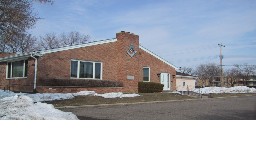 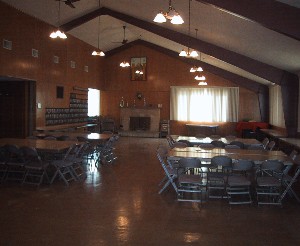 12
One memorable day Bro. Gary A. Hoonsbeen brought his
1912 Maxwell and his 1908 Oldsmobile to our parking lot for us
to inspect and test drive. Bro. Hoonsbeen took three of us on a
wild ride at about 15 mph around the neighborhood, including a
drive through the local Buick auto dealership shouting for
"SERVICE"!
In 1987 Cataract News, with 20/20 foresight, predicted
that by the year 2000 Cataract Lodge would be involved in a
merger as a result of declining membership.
7615 Logan Avenue South, Richfield
1978 - 2001
Richfield Masonic Center Dining Room
1978 - 2001
|
|
13
LOSS OF RICHFIELD MASONIC CENTER
In 1999, the City of Richfield advised Richfield and
Century Lodges of its intent to redevelop the southwest
quadrant of the City, including the Lodge property located at
7615 Logan Avenue South. In response, the respective
leaderships of Richfield, Century and Cataract Lodges used
the proposed redevelopment, taking and relocation to evaluate
their respective status, organization and goals for future
Masonic development.
Following serious “soul-searching”, Richfield,
Century and Cataract Lodges determined to merge their
respective memberships, and consolidate assets into a single
entity to best grow Masonry in the South Metro Area.
Effective December 2000, the three Lodges merged into one
combined Lodge consisting of 619 members. Honoring
Cataract’s unique position in the development of Minnesota
Masonry, the combining Lodges elected to retain the Cataract
Charter and surrender the Richfield and Century Charters.
To accomplish this goal the Lodges established two
committees, a relocation committee and a merger committee.
The relocation committee, among other things, obtained an
appraisal of the Richfield Masonic Center for use in
negotiating the terms under which the Lodges would vacate
the premises. The merger committee obtained approval of a
proposed line of officers and determined that Cataract's by-
laws would have to be revised at a later date. The committee
resolved that a celebration of the heritage of the three merged
lodges should be held annually.
Concurrently, the City’s redevelopment plan
continued unabated. The project eventually became known as
the “Best Buy Corporate Campus”. Subsequently, the Lodge
property was conveyed under threat of eminent domain in
March 2001, with Cataract Lodge No. 2, relocating to
Minnehaha Masonic Center, 5149 Bloomington Avenue
South, Minneapolis, Minnesota, in June 2001.
|
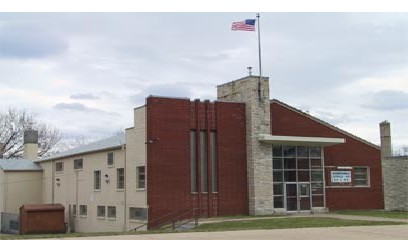 14
CATARACT LODGE #2 A.F. & A.M. IN 2002
5149 BLOOMINGTON AVENUE SOUTH, MINNEAPOLIS
THE NEW HOME OF CATARACT LODGE #2
As a result of the conveyance of Richfield Masonic Center under
threat of eminent domain in June 2001, Cataract Lodge #2 moved to the
Minnehaha Masonic Center at 5149 Bloomington Avenue South in
Minneapolis. Moving day came and we found a large dumpster outside in
our parking lot. We filled the dumpster to overflowing and then divided
everything else between our new home, Grand Lodge storage and the
Minnesota Masonic Museum. Some of the items from the museum are on
display at our birthday celebration.
Minnehaha Masonic Center is a fine building, superior in some
respects to our former home in Richfield. We were warmly received by the
Master and members of Minnehaha Lodge and our beautiful Lodge
furniture was promptly installed in the Lodge room. We have an office in
the lower level for our Secretary and computer with lots of storage space.
Our July 2001 stated meeting was a unique event, a joint meeting
with Minnehaha Lodge. This meeting was scheduled as Minnehaha
Lodge's by-laws require a stated meeting on the first Tuesday after a
holiday. Two worshipful masters shared responsibility and perhaps started
a new tradition.
Cataract Lodge #2 is a tenant at Minnehaha Masonic Center.
Some of our members hope we will go back to the Southwest metro area
while others applaud the return to Minneapolis. Cataract Lodge #2 moves
on average about once every twenty years. For the present, we have a fine
new home.
|
|
15
RICHFIELD LODGE #334 A.F. & A.M.
The rapid growth of Richfield and Minneapolis southward
beyond 50th street in the early twenties gave impetus to the project of
locating a Masonic Lodge in that area. In 1925 Clark Nicholson, a life
time resident of the area known as Nicholson Park, constructed a
building at 5415 Nicollet Avenue with a hall on the second story
known as Towns Edge Hall, with the hope that a Masonic Lodge would
be organized to meet therein. Shortly thereafter, preliminary meetings
were held and calls were made on residents of the neighborhood known
to be Masons.
At that time Towns Edge Hall was in Richfield. Fifty-fourth
street being the boundary line, and "Richfield" was the only name
considered for the lodge being organized. In 1926 the boundary of
Minneapolis was extended to sixty-second street, so Richfield Lodge,
when dispensation was granted on June 13, 1927, was a Minneapolis
Lodge, and so remained until September 1, 1959, when the Lodge
moved to 7615 Logan Avenue South, Richfield, MN.
Richfield Lodge #334 was chartered in January 1927. The
Lodge had 94 charter members. It grew with the growth of the
neighborhood in the late twenties and early thirties until the general
business depression of the thirties slowed
the growth. In the early
forties it resumed its growth and had a steady increase in membership
since that time. Membership in Richfield Lodge peaked in the year
1971 at 577. George Benedict was Master that year. Kendell Conway
was on the Building Committee and supervised the construction of the
Lodge Hall located at 7615
Logan Avenue South. He was Master in
1967. Albin Palmersten served as Secretary for 27 years and was
Master in 1949. David Palmer served as Grand Secretary of the Grand
Lodge of Minnesota from 1955 to 1968 and was Master in 1947.
Douglas Campbell began as Grand Secretary in 1997 and continues at
the present time. He served as Master in 1988. Frederick Vihovde
served as Grand Treasurer from 1988 to 1993 and was Master in 1975.
Recent Grand Lodge Monitors have included Ronald Kennedy (Master
1973), Gary Bill (Master 1992), and Douglas Campbell.
The Lodge building at 7615 Logan was constructed with
volunteer labor from members of Richfield and Century Lodges.
Richfield Chapter #293, OES served meals to the volunteers during the
construction phase.
Richfield Lodge had a program for many years that awarded
scholarships to students of Richfield High School.
|
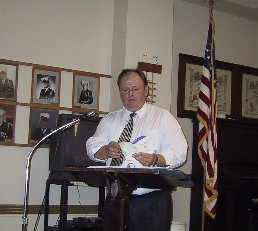 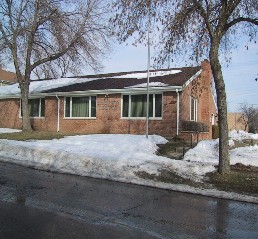 16
The Lodge also had a biannual pancake breakfast in
partnership with Century Lodge. The profits from these events were
used to pay the real estate taxes on the building and grounds.
Richfield Chapter #293 OES also operated a boutique as a "fund
raiser" at the pancake breakfasts assisted by Jobs Daughters Bethel #1
and Demolay.
Junior Warden Lee Weich holding OES Bible
found in time capsule behind the Richfield
Masonic Center cornerstone
Richfield Masonic Center,
7615 Logan Avenue South
Demolished 2001
|
|
17
CENTURY LODGE NO. 338, A.F. & A.M.
In the early 1950's, W.B. Norman Barsness, Past Master of Mystic Lodge
#213, Aitkin, MN, realized that additional masonic work needed to be accomplished in
the fastest growing community in Minnesota, the village of Richfield. While operating a
drugstore at 76th and Lyndale Ave. So., Barsness applied to the Grand Lodge of
Minnesota for a petition for dispensation to form a new lodge. He inquired of friends,
acquaintances, business associates, customers, and any other person he knew to be a
Mason if they were interested signing his petition. Almost all who signed were Masons
from other areas who were living and working in the southern suburbs and far from
their home lodges. They were all interested in organizing masonic work.
By 1952, Barsness had enough signatures to apply to the Grand Lodge for
dispensation to organize. Meetings were held in the Barsness basement to select
officers, form committees, and plan the future. The Grand Lodge granted disposition on
November 20, 1952, and E. Norman Barsness was elected Worshipful Master, the only
one eligible to hold the chair. The name "Century" was the suggestion of Senior
Warden elect, Harry Rumpel, to commemorate the 100th Anniversary of the Grand
Lodge of Minnesota in 1953. A committee was formed to apply to Richfield Lodge
#334, then meeting at 5417 Nicollet Ave So. in Minneapolis, for help and assistance.
They graciously responded and contributed free use of their facilities and equipment.
The first stated meeting of Century Lodge, Under Dispensation, was held on
December 16, 1952 with W.B. E. Norman Barsness in the East; Harry Rumpel, S.W.;
Donald Bethke, J.W.; Newton Sarff, Treasurer; Stuart Frasier, Secretary; Guy Dillman,
S.D.; Aldrich Casey, J.D.; Earl Beddow, Chaplain; Amos Fester, S.S.; Reid Macomber,
J.S.; and Wilber Johnson, Tyler. These officers remained in their stations and places
until the first year was completed after being constituted, after which new officers were
elected and installed.
The charter was granted on March 18, 1954 by Most
Worshipful Brother Harvard T. Olson, Grand Master of Masons of Minnesota.
Richfield Lodge #334 and Lake Harriet Lodge #277 of Minneapolis were the official
sponsors.
Century Lodge was constituted at an Occasional Communication of the Grand
Lodge with M.W.B. Leroy E. Matson, Grand Master presiding.
Century Lodge
grew rapidly in both membership and prosperity. As an example, 27 candidates were
eligible to be raised by the time the charter was granted. In 1979, its 25th year, the
lodge reached its highest number with over 500 members.
Century had a very capable line of officers during its life and conducted
excellent degree work. At one time Century had five Monitors in the Grand Lodge
Councilor Program. Right Worshipful Brother Terry Tilton, a former member, will be
the Grand Master of Minnesota Masons in 2003.
During the years, Century, Richfield, and the Richfield O.E.S. #293 had a
very amiable relationship. The three groups cooperated on the construction of the
wonderful Masonic Temple at 76th and Logan Ave. So. in Richfield, the pancake
breakfasts, and the Third Degree dinners. The two lodges shared the management of the
Temple by the Trustees, and the conferral of the Actual Past Masters Degree for the two
masters elect.
Century Lodge also conducted a very successful school scholarship program
for Richfield High School. It was named for W.B. Harry Rumpel, long time
superintendent of the Richfield School System.
Century cooperated with the Minnesota Masonic Home in Bloomington, MN
first by purchasing the furnishings for a room at the newly expanded care center in 1967
|
|
18
and later helping in landscaping and constructing the Square and Compass garden.
For many years Century conducted its December Stated Meeting at the Masonic
Home along with sponsoring a musical program by the Zuhrah Temple Chanters for
the residents and guests.
Century Lodge, along with Masonry in general, has been part of the
decline in membership, and in 1999 voted to combine with Richfield Lodge #334
and Cataract Lodge #2, which at the time was a renter at the Richfield Temple.
With reluctance, Century returned its charter to the Grand Secretary, thus ending its
active life at 47 years. The name Century Lodge #338 is no longer in use and its
members are part of Cataract Lodge #2, but its memory will long be revered and its
name never forgotten.
|